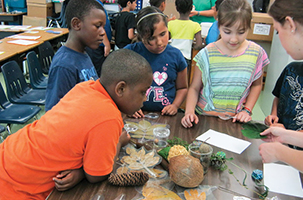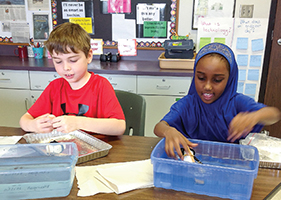Expanding the View of Giftedness
September 01, 2015

“Now I view myself as a talent scout, always thinking of how I can challenge my students so that I can see what they are capable of.”
-Lisa Rogers, gifted education specialist, Marietta, Ga.
With what seem to be ever-increasing demands on educators and limited resources, turning all teachers into trained talent scouts would appear to be a lofty ideal in K-12 education.
But absent such a commitment to proactively identify talent by knowing what to look for and nurturing it to the point of excellence, countless students go unidentified for advanced learner services. This results in a significant amount of talent going undeveloped or underdeveloped, which is a loss not only for the students but also for their communities and our nation.
Fortunately, school districts in various communities are putting in place effective programs to develop the talents and abilities of students who have high ability but who may not be demonstrating high achievement. These places, while somewhat limited in number, deliver challenging curriculum commensurate with the students’ abilities.
Some district initiatives stem from an effort to close the “excellence gaps,” or disparities among students reaching advanced achievement levels. Other districts want to ensure their gifted education programs fully reflect the districts’ diversity.

Talent Searches
Districts are addressing this need by expanding the view of giftedness, systematically searching for students with the potential to achieve at high levels and creating programs and services that emphasize identifying students from culturally, linguistically and ethnically diverse and/or economically disadvantaged populations.
Some operate as gateway initiatives intending to identify and develop talented students who can be moved on to traditional gifted and talented programs and other advanced coursework, while some provide standalone services.
Three fundamental elements found in each of these programs include:
- Use of Multiple Identification Criteria. Each program uses multiple criteria to assess students for services, including observation checklists, student work samples and nonverbal ability tests to identify students from traditionally underrepresented
populations.
- A Staff of Appropriately Trained and Committed Professionals. Each program employs willing educators trained to identify and serve gifted learners: These staff provide professional development to participating teachers.
- Commitment of District Leadership. Of particular importance, each program director described the support of district-level and building-level leaders as essential.
Exemplary Programs
When it comes to an exemplary school-based program to identify and develop students on the cusp of excellence, a promising district-based initiative is the Young Scholars Program in Fairfax County, Va.
Launched 15 years ago with 35 students in one school, the program now operates in 84 of 139 elementary schools and reaches more than 5,700 students. The program reflects the ethnic and cultural diversity of the school district and has nearly twice the percentage of students (54 percent) who are eligible for free or reduced-price lunch compared to the district as a whole.
Beginning in kindergarten, educators observe students and create portfolios of work to identify children with gifted potential. “Ongoing assessments by teachers who have been trained to provide instruction designed to elicit higher-level thinking may be the most powerful means of identifying advanced learners from low economic and minority populations,” says Carol Horn, K-12 coordinator of advanced academic programs in Fairfax County.
Each Young Scholars school has a half-time resource teacher with credentials in gifted education who implements the program. The scholars are clustered with teachers who provide challenging and engaging learning experiences. Summer school, after-school sessions and field trips provide further enrichment.
The program’s long-term goal is to nurture participants so they can be prepared for gifted education and other rigorous programing in upper elementary, middle and high school. Twenty-seven percent of scholars in grades 3-8 are served in full-time gifted programs, and another 23 percent receive part-time services in elementary grades or honors classes in the middle school. And 95 percent of the scholars take Advanced Placement, International Baccalaureate or honors classes in high school.
Demonstrating Skills
While a fraction of the size of Fairfax, the 9,000-student Eden Prairie, Minn., school district launched a similar Young Scholars program in 2011, serving about 55 students each year in grades 1 and 2.
According to Sue Feigal-Hitch, coordinator of gifted services, the district identifies students based on four demonstration lessons conducted by the gifted education resource teacher while the classroom teacher observes to spot signs of higher-level creative and critical thinking. Identified students gather in a resource room once a week to build background knowledge and vocabulary and to develop study skills.
During the first two years of the program’s operation, 29 percent of the Young Scholars have been admitted to the grades 2-6 pullout gifted education program, and the number of students from underrepresented groups has increased in a new full-time program for highly gifted students.
In nearby Bloomington, Minn., the district launched its Alfred Nobel program targeting creatively gifted students in 2013 at the most diverse middle school in the district. The program tries to develop talent in high-ability students through a rigorous humanities approach focused on critical thinking and creativity.
“We found that many students with innovative ideas and creative skills may not be the rule followers or the highest achievers and that they often approach tasks in a more nontraditional way,” says Erin Boltik, director of gifted programs and services. “We had to do something a little different and have seen that teachers are beginning to understand that there are different ways to be gifted.”
Students who score at the 80th percentile or above on Northwest Evaluation Association’s Measures of Academic Progress are given the Torrance Test of Creativity before being accepted into the program. Two of seven classes a day are spent in the Nobel courses; Bloomington hopes to increase this to three classes per day.
The school district has 20 students per grade in each Nobel class, but interest has resulted in a waiting list.
Multiple Assessments
The Paradise Valley Unified School District in suburban Phoenix, Ariz., serves about 32,000 students with 37 percent eligible for free or reduced-price lunch; and about 30 percent are of Hispanic descent.
Arizona’s gifted education mandate requires districts to assess students three times each year and establishes statewide criteria for identifying gifted students.
“A comprehensive process that strives to identify all students with high ability, even if they are not yet high achievers, is necessary if they are to have consistent opportunities to make academic progress every day, month and year,” says Dina Brulles, Paradise Valley’s director of gifted education.
The district begins by learning as much about the students as possible, beginning with an identification process that uses a range of instruments. A gifted specialist at every elementary school provides site-based training to help staff recognize characteristics and behaviors of gifted students, including those from diverse populations. Thirty-two percent of the students receiving gifted education services are nonwhite compared to 45 percent in the overall student population.
Once students are identified as gifted, they are placed in the program regardless of their previous achievement levels. Students are clustered with other high-ability peers, a grouping tactic Paradise Valley discovered helps them develop advanced skills as a group.
In grades 4-6, gifted students are placed in a daily pullout program with enriched mathematics and language arts content, and highly gifted students are accelerated in a self-contained program with content at least two years above grade level. After elementary school, students can access an array of options, including an honors program designed for culturally and linguistically diverse learners.
A Watch List
Like the other districts, Englewood, Colo., with 3,000 students, relies on multiple criteria to identify approximately 250 students for gifted education services. Leaders in this high-poverty district with a large percentage of English language learners have made increasing the diversity of students receiving gifted education services a priority.
The district maintains a talent pool watch list of students who demonstrate potential but whose performance is not yet strong enough for gifted program placement, and teachers are encouraged to actively track these students’ progress.
“We have some work to do on increasing our program’s diversity,” says Gail Stine, Englewood’s gifted and talented coordinator. “But we’re making progress, largely because of increased teacher awareness of what students are capable of.”
Each school has a gifted education teacher and mental health liaison who are committed to becoming the experts in gifted education for their building.
Tailored Programs
These five district-level programs demonstrate that a focused commitment to high-ability students from disadvantaged and underrepresented populations pays off with increased high-order skills and achievement. While every program must be tailored to fit the goals and needs of each district, evidence-based strategies can be replicated and customized to deliver results.
Administrators can — and must — play a role in such programs if they are to succeed. This involvement and commitment must come at all levels, from district mission statements and priorities on down, to ensure building-level professionals have the training and resources they need to identify and develop such learners.
Additional Resources
Jane Clarenbach of the National Association for Gifted Children suggested these informational resources related to her article:
- A short teacher guide for understanding children who may have disabilities along with gifts and talents. Access “The Twice Exceptional Dilemma” at www.nea.org/assets/docs/twiceexceptional.pdf.
- An overview of the impact of poverty on high ability and the factors behind successful programs. Access “Unlocking Emergent Talent” at http://bit.ly/unlocking-talent.
- A handbook for educators, “Identifying Gifted and Talented English Language Learners, Grades K-12,” covers such issues as addressing bias in assessment instruments. Access at http://bit.ly/identifying-gifted-talent.
- A three-hour online professional development course on the Young Scholars program in Fairfax County, Va., is available through CaseNex at www3.casenex.com.
Advertisement
Advertisement
Advertisement
Advertisement



